Ultimate Support Pressure Determination for Shield Tunnel Faces in Saturated Strata Based on Seepage Flow Control
Abstract
:1. Introduction
2. Problem Statement
3. Calculation of Seepage Field
3.1. Numerical Model and Analysis of Calculation Results
3.2. Theoretical Calculation Method for Seepage Field in Shield Tunnel Excavation
4. Calculation of Ultimate Support Pressure for Shield Tunnel Face
4.1. Establishment of the Three-Dimensional Failure Mechanism
4.2. Functional Equation
5. Method Comparison Validation and Parameter Analysis
5.1. Method Comparison Validation
5.2. Impact of Seepage on σt/γsatD
5.3. Impact of Seepage on Failure Mechanisms
6. Calculation Method of Tunnel Face Support Pressure Based on Seepage Control
6.1. Determination of Target Water Pressure at Tunnel Face
6.2. Calculation Method
6.3. Comparison Considering Seepage Control
7. Conclusions
- (1)
- Based on the two-dimensional Laplace control equation combined with the seepage numerical analysis model, the water head calculation formula under steady-state seepage conditions in saturated soil is derived. This formula is incorporated into the three-dimensional limit analysis model. The calculation results are consistent with existing research, verifying the reliability of the analysis model.
- (2)
- The ultimate support pressure σt increases linearly with the water level and the tunnel face water pressure coefficient η. The interaction between the water level and η exacerbates the increase in σt. As the water level and η increase, the three-dimensional failure mechanism transitions from an extended forward shape to a more contracted form with a reduction in volume. The influence of η on the failure mechanism shape is significantly greater than that of the water level.
- (3)
- The tunnel face water pressure coefficient η is mainly influenced by the seepage flow at the tunnel face, the permeability coefficient of the stratum, and the water level. These three parameters can be used to calculate the appropriate η. Based on this, a method for calculating the ultimate support pressure of the shield tunnel faces considering seepage control is proposed. Comparative studies with other methods in practical engineering projects demonstrate the superiority of this method and the necessity of considering seepage control. This method allows for a more reasonable calculation of the tunnel face water pressure and support pressure.
8. Discussion
Author Contributions
Funding
Institutional Review Board Statement
Informed Consent Statement
Data Availability Statement
Conflicts of Interest
Abbreviations
| C, D | Buried depth and tunnel diameter |
| hw, h0 | Water level measured from the top and bottom of the tunnel |
| hF,A | Water head at the center of the tunnel face |
| k | Permeability coefficient |
| η | Water head coefficient at the tunnel face |
| a, b, c, d | Seepage boundary function fitting parameters |
| N | Truncation term in seepage calculation |
| ui | Pore water pressure at any point |
| σ, γ, e, w | Power of support pressure, weight of soil, cohesion, and pore water pressure |
| Vi,j | Volume of the triangular element |
| Si,j, Σi,j | Area of triangular and quadrilateral elements |
| βi,j, Ri,j | Discrete element’s rotation angle and radius |
| σt | Limit support pressure |
| Aj | Discrete points on the tunnel face |
| Cj | The geometric center of radial planes |
| c, φ | Effective cohesion and internal friction angle |
| ω | Angular velocity of the failure mechanism rotating about point O |
| Pi,j | Discrete points on the failure mechanism |
Appendix A
References
- Lei, M.; Shi, Y.; Tang, Q.; Sun, N.; Tang, Z.; Gong, C. Construction control technology of a four-hole shield tunnel passing through pile foundations of an existing bridge: A case study. J. Cent South Univ. 2023, 30, 2360–2373. [Google Scholar] [CrossRef]
- Liu, J.; Shi, C.; Gong, C.; Lei, M.; Wang, Z.; Peng, Z.; Cao, C. Investigation of ultimate bearing capacity of shield tunnel based on concrete damage model. Tunn. Undergr. Space Technol. 2022, 125, 104510. [Google Scholar] [CrossRef]
- Lei, M.; Liu, L.; Shi, C.; Tan, Y.; Lin, Y.; Wang, W. A novel tunnel-lining crack recognition system based on digital image technology. Tunn. Undergr. Space Technol. 2021, 108, 103724. [Google Scholar] [CrossRef]
- Lei, M.; Peng, L.; Shi, C. An experimental study on durability of shield segments under load and chloride environment coupling effect. Tunn. Undergr. Space Technol. 2014, 42, 15–24. [Google Scholar] [CrossRef]
- Zhao, C.; Lei, M.; Shi, C.; Cao, H.; Yang, W.; Deng, E. Function mechanism and analytical method of a double layer pre-support system for tunnel underneath passing a large-scale underground pipe gallery in water-rich sandy strata: A case study. Tunn. Undergr. Space Technol. 2021, 115, 104041. [Google Scholar] [CrossRef]
- Zou, J.; Qian, Z.; Xiang, X.; Chen, G.H. Face stability of a tunnel excavated in saturated nonhomogeneous soils. Tunn. Undergr. Space Technol. 2019, 83, 1–17. [Google Scholar] [CrossRef]
- Li, W.; Zhang, C. Face Stability Analysis for a Shield Tunnel in Anisotropic Sands. Int. J. Geomech. 2020, 20, 04020043. [Google Scholar] [CrossRef]
- Shi, Z.; Xu, J.; Xie, X.; Li, P.; Chai, L.; Li, S. Failure mechanism analysis for tunnel construction crossing the water-rich dense fracture zones: A case study. Eng. Fail. Anal. 2023, 149, 107242. [Google Scholar] [CrossRef]
- Zhang, X.; Wang, M.; Lyu, C.; Tong, J.; Yu, L.; Liu, D. Experimental and numerical study on tunnel faces reinforced by horizontal bolts in sandy ground. Tunn. Undergr. Space Technol. 2022, 123, 104412. [Google Scholar] [CrossRef]
- Lü, X.; Zhao, Y.; Xue, D.; Lim, K.; Qin, H. Numerical modelling of shield tunnel face failure through a critical state sand plasticity model with nonlocal regularization. Comput Geotech. 2023, 164, 105847. [Google Scholar] [CrossRef]
- Di, Q.; Li, P.; Zhang, M.; Cui, X. Experimental study of face stability for shield tunnels in sandy cobble strata of different densities. Tunn. Undergr. Space Technol. 2023, 135, 105029. [Google Scholar] [CrossRef]
- Liu, C.; Zhang, S.; Zhang, D.; Zhang, K.; Wang, Z. Model tests on progressive collapse mechanism of a shallow subway tunnel in soft upper and hard lower composite strata. Tunn. Undergr. Space Technol. 2023, 131, 104824. [Google Scholar] [CrossRef]
- Senent, S.; Jimenez, R. A tunnel face failure mechanism for layered ground, considering the possibility of partial collapse. Tunn. Undergr. Space Technol. 2015, 47, 182–192. [Google Scholar] [CrossRef]
- Mollon, G.; Dias, D.; Soubra, A. Probabilistic Analysis of Pressurized Tunnels against Face Stability Using Collocation-Based Stochastic Response Surface Method. J. Geotech. Geoenviron. 2011, 137, 385–397. [Google Scholar] [CrossRef]
- Subrin, D.; Wong, H. Stabilité du front d’un tunnel en milieu frottant: Un nouveau mécanisme de rupture 3D. Comptes Rendus. Mecanique. 2002, 330, 513–519. [Google Scholar] [CrossRef]
- Chen, W.F.; Scawthorn, C.R. Limit analysis and limit equilibrium solutions in soil mechanics. Soils Found. 1970, 10, 13–49. [Google Scholar] [CrossRef] [PubMed]
- Mollon, G.; Dias, D.; Soubra, A. Face Stability Analysis of Circular Tunnels Driven by a Pressurized Shield. J. Geotech. Geoenviron. 2010, 136, 215–229. [Google Scholar] [CrossRef]
- Mollon, G.; Dias, D.; Soubra, A. Rotational failure mechanisms for the face stability analysis of tunnels driven by a pressurized shield. Int. J. Numer. Anal. Met. 2011, 35, 1363–1388. [Google Scholar] [CrossRef]
- Zhang, D.; Jiang, J.; Zhang, J. The Stability of Upper Bound Analysis of Soft Rock Tunnel Faces Under Different Underground Water Levels. Geotech. Geol. Eng. 2021, 39, 4393–4404. [Google Scholar] [CrossRef]
- Yin, X.; Chen, R.; Meng, F. Influence of seepage and tunnel face opening on face support pressure of EPB shield. Comput. Geotech. 2021, 135, 104198. [Google Scholar] [CrossRef]
- Pan, Q.; Dias, D. The effect of pore water pressure on tunnel face stability. Int. J. Numer. Anal. Met. 2016, 40, 2123–2136. [Google Scholar] [CrossRef]
- Hou, C.; Pan, Q.; Xu, T.; Huang, F.; Yang, X. Three-dimensional tunnel face stability considering slurry pressure transfer mechanisms. Tunn. Undergr. Space Technol. 2022, 125, 104524. [Google Scholar] [CrossRef]
- Liu, J.; Liu, L. Stability of Tunnel Face Reinforced by Bolts under Seepage Flow Conditions. KSCE J. Civ. Eng. 2022, 26, 977–986. [Google Scholar] [CrossRef]
- Anagnostou, G. The influence of tunnel excavation on the hydraulic head. Int. J. Numer. Anal. Met. 1995, 19, 725–746. [Google Scholar] [CrossRef]
- Perazzelli, P.; Leone, T.; Anagnostou, G. Tunnel face stability under seepage flow conditions. Tunn. Undergr. Space Technol. 2014, 43, 459–469. [Google Scholar] [CrossRef]
- Li, W.; Zhang, C.; Tan, Z.; Ma, M. Effect of the seepage flow on the face stability of a shield tunnel. Tunn. Undergr. Space Technol. 2021, 112, 103900. [Google Scholar] [CrossRef]
- Di, Q.; Li, P.; Zhang, M.; Guo, C.; Wang, F.; Wu, J. Three-dimensional theoretical analysis of seepage field in front of shield tunnel face. Undergr. Space 2022, 7, 528–542. [Google Scholar] [CrossRef]
- Di, Q.; Li, P.; Zhang, M.; Zhang, W.; Wang, X. Analysis of face stability for tunnels under seepage flow in the saturated ground. Ocean Eng. 2022, 266, 112674. [Google Scholar] [CrossRef]
- Di, Q.; Li, P.; Zhang, M.; Jia, Y.; Li, S.; Cui, X. Experimental study on the effect of seepage flow on the tunnel face stability in the saturated ground. Ocean Eng. 2024, 299, 117074. [Google Scholar] [CrossRef]
- Di, Q.; Li, P.; Zhang, M.; Wu, J. Influence of permeability anisotropy of seepage flow on the tunnel face stability. Undergr. Space 2023, 8, 1–14. [Google Scholar] [CrossRef]
- Bear, J. Hydraulics of Groundwater; Mc Graw-Hill: New York, NY, USA, 1979. [Google Scholar]
- Zhang, Y. Study on the Hydraulic Flow Regime Characteristics in Subsea Tunnels and Its Engineering Application. Ph.D. Thesis, Beijing Jiaotong University, Beijing, China, 2021; pp. 56–61. (In Chinese). [Google Scholar]
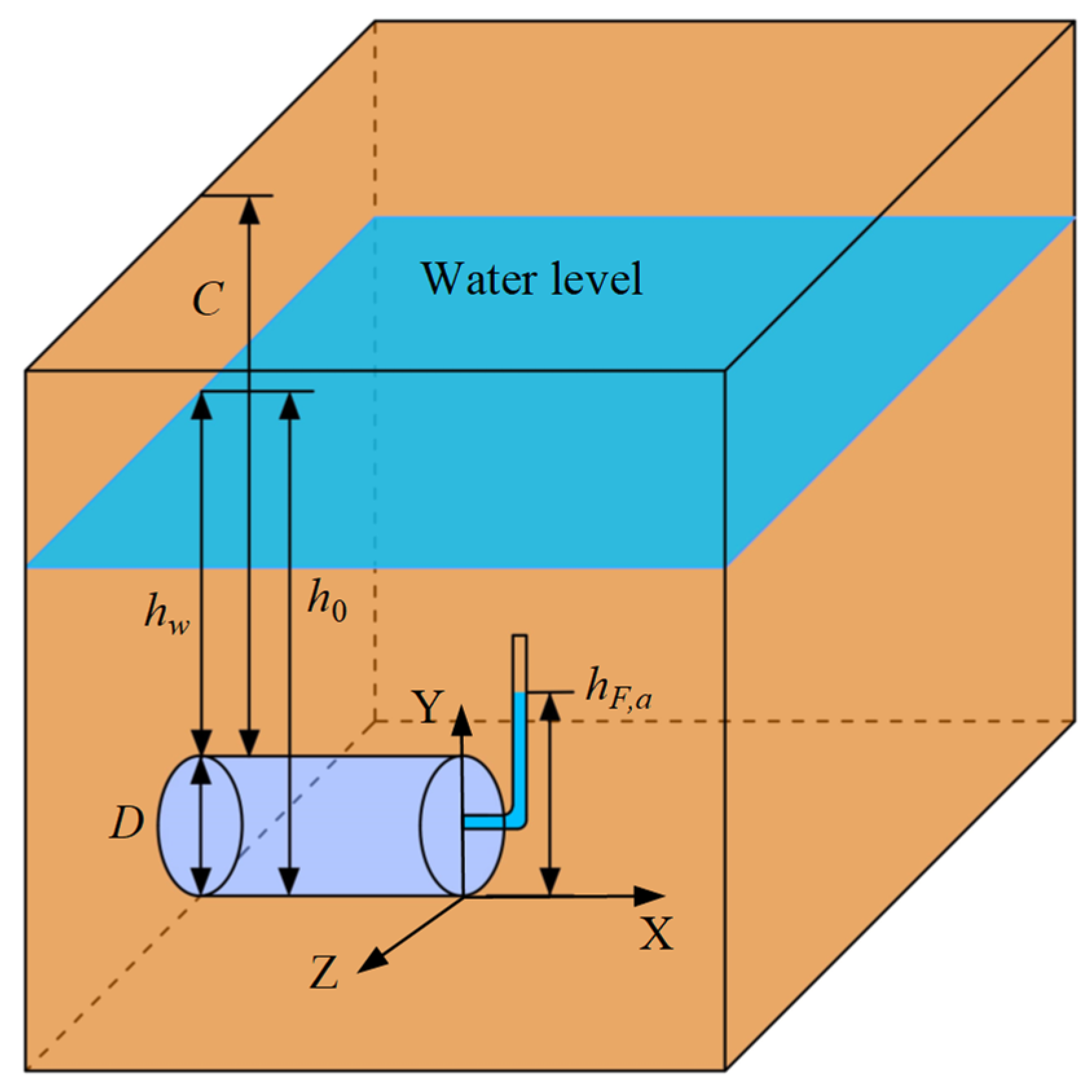


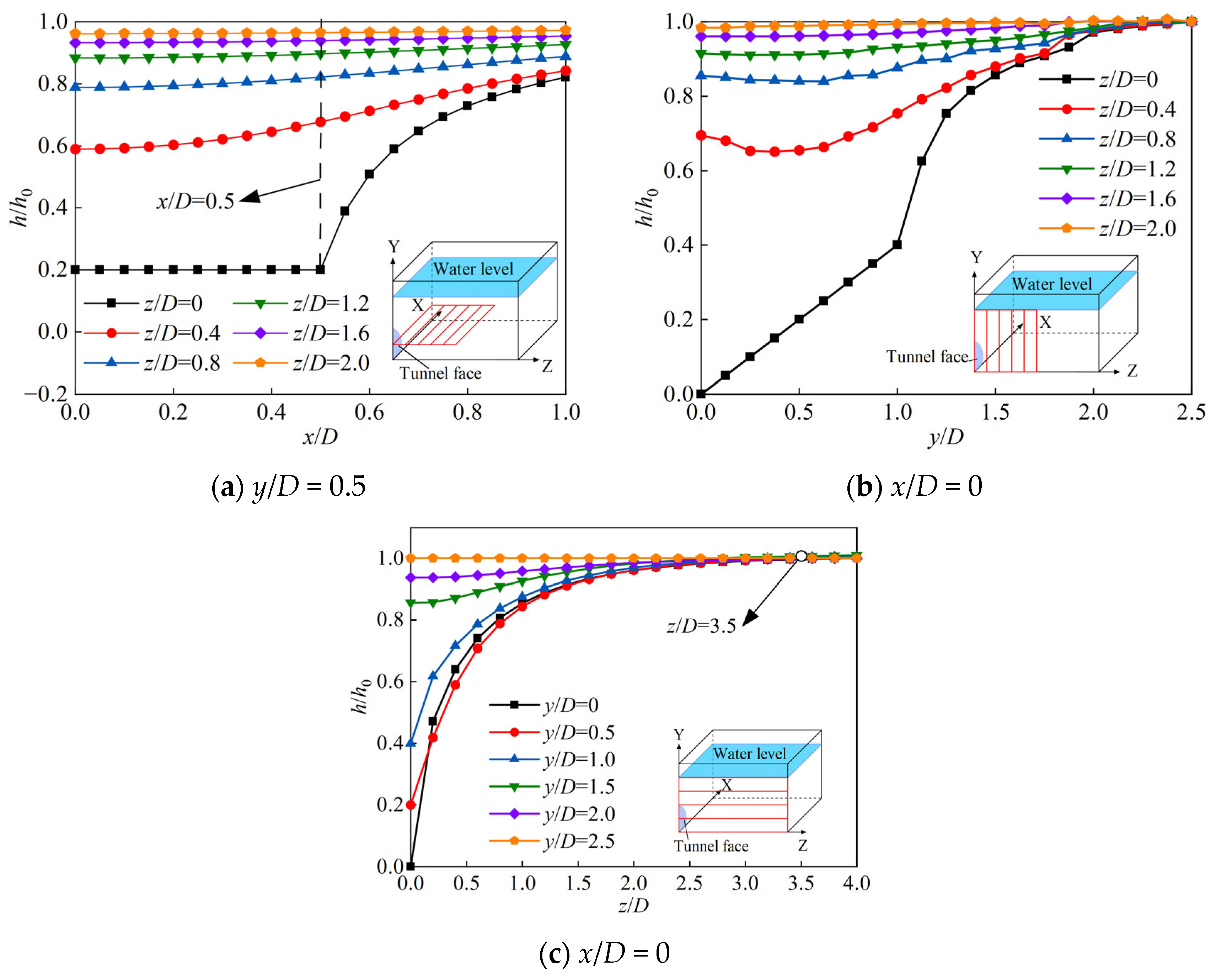
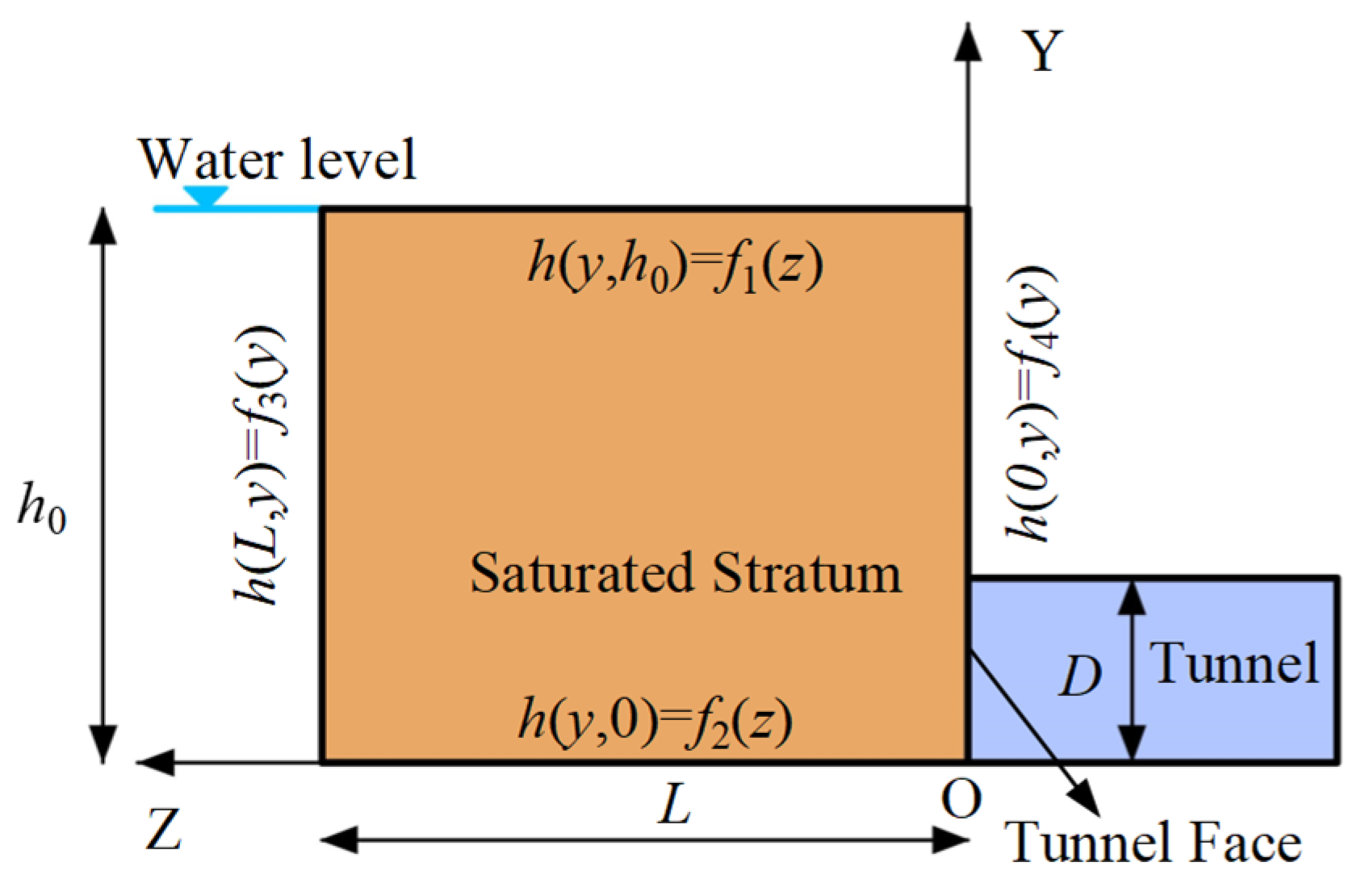
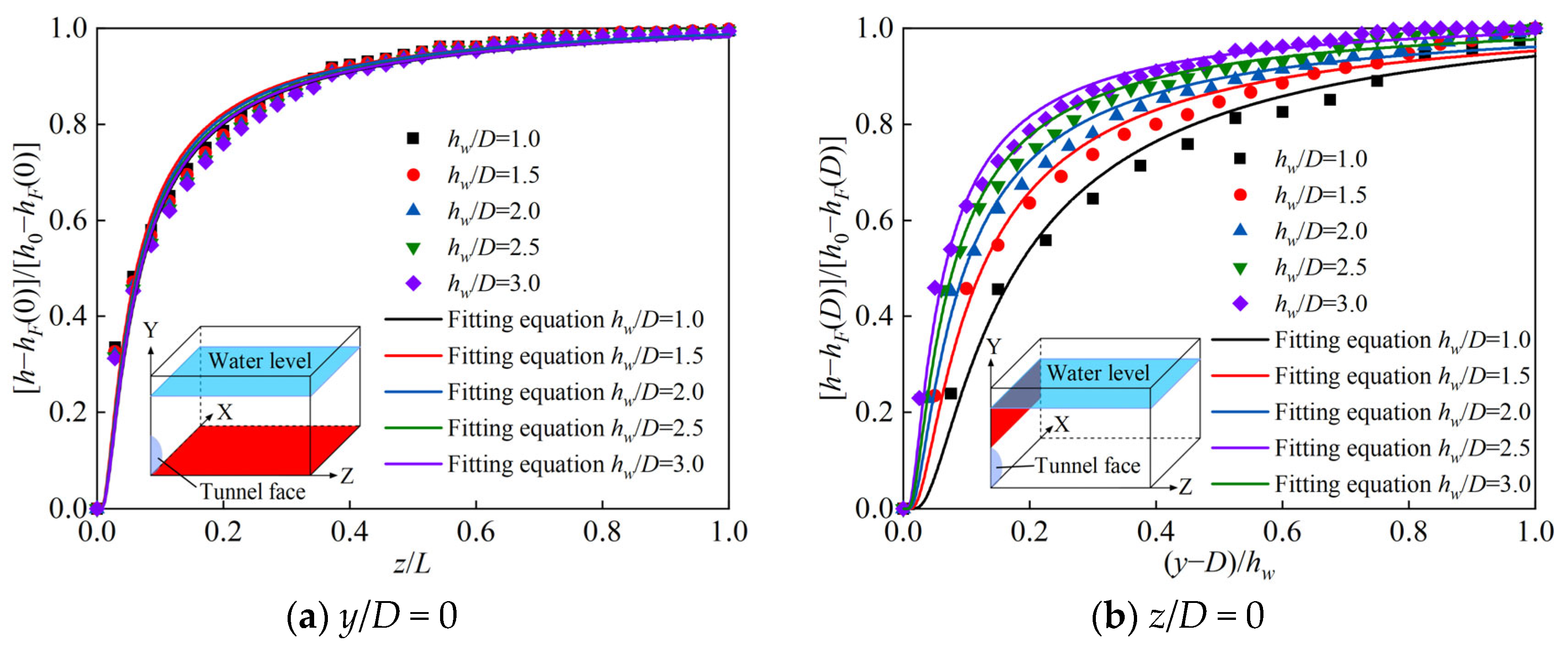
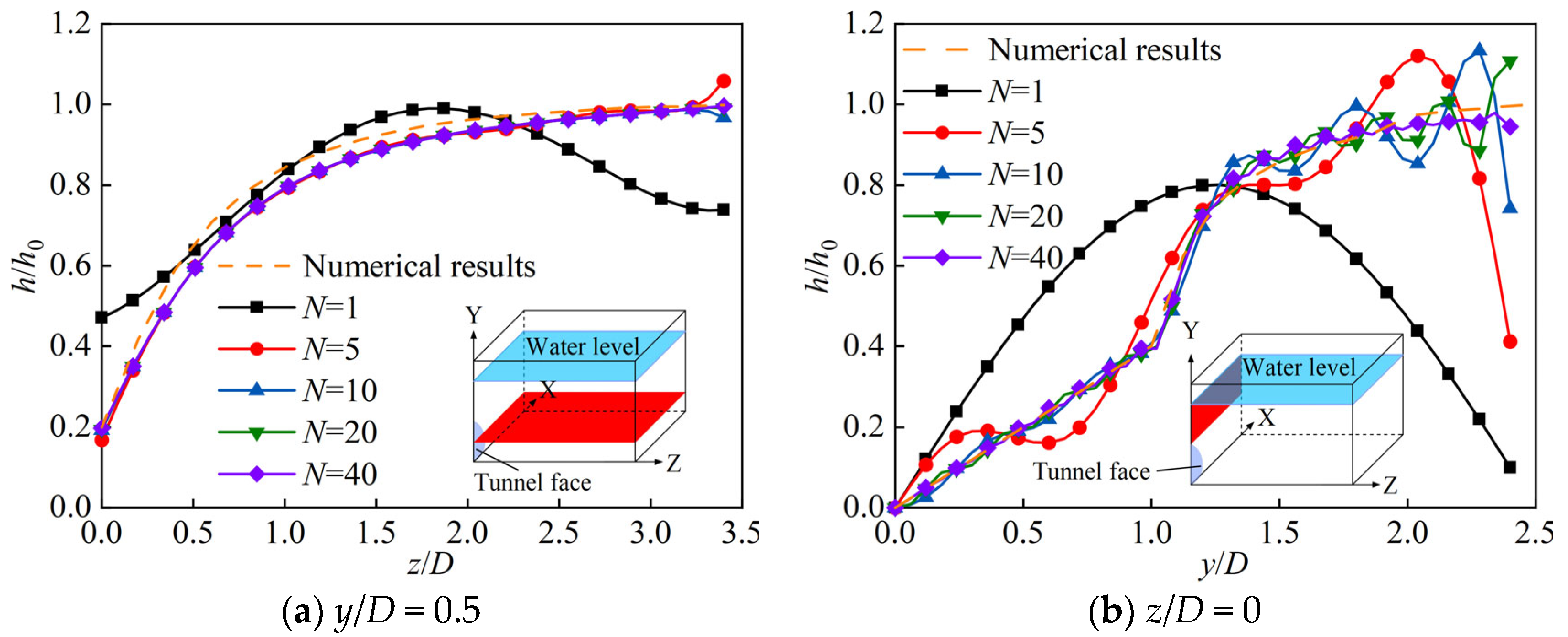

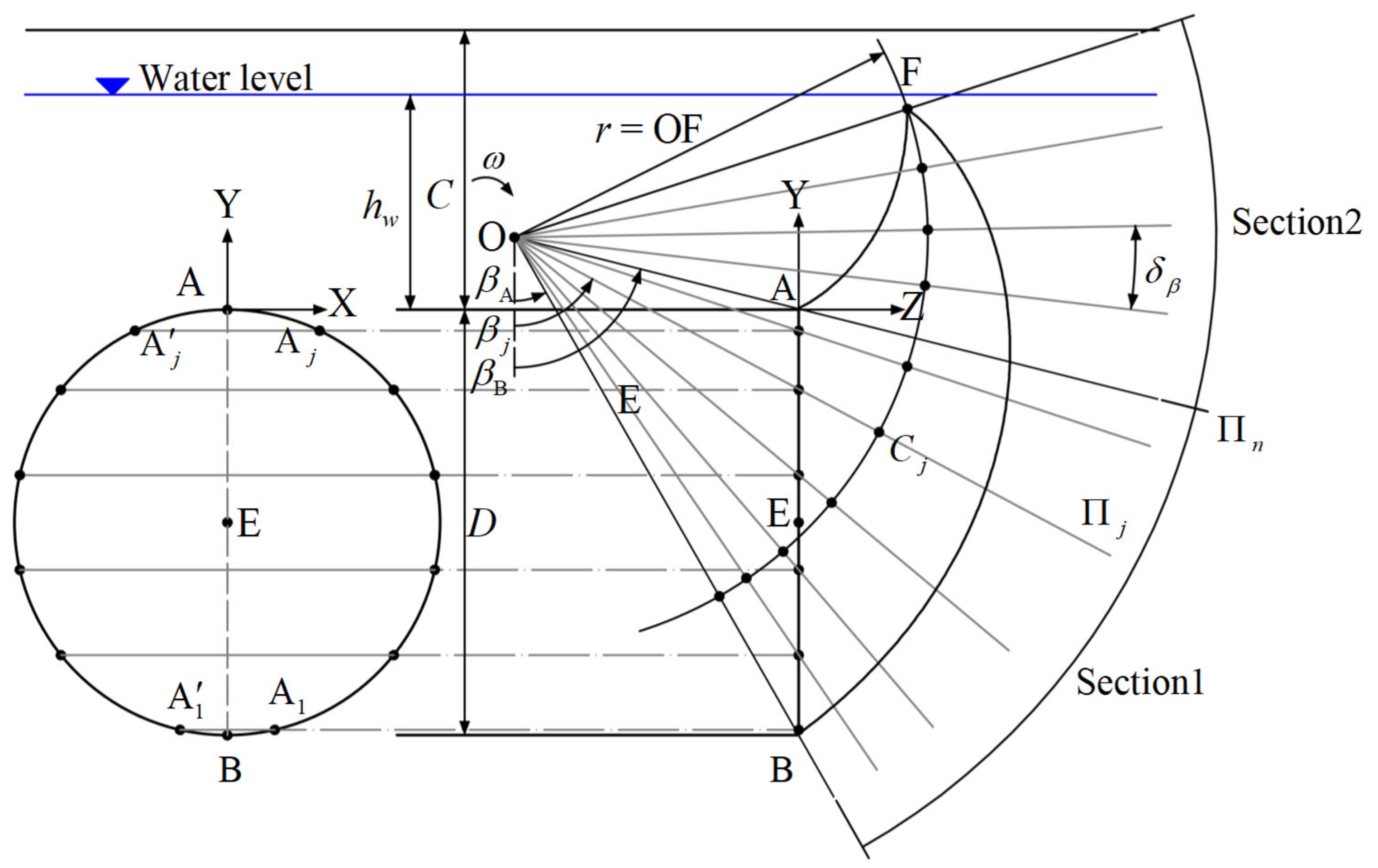

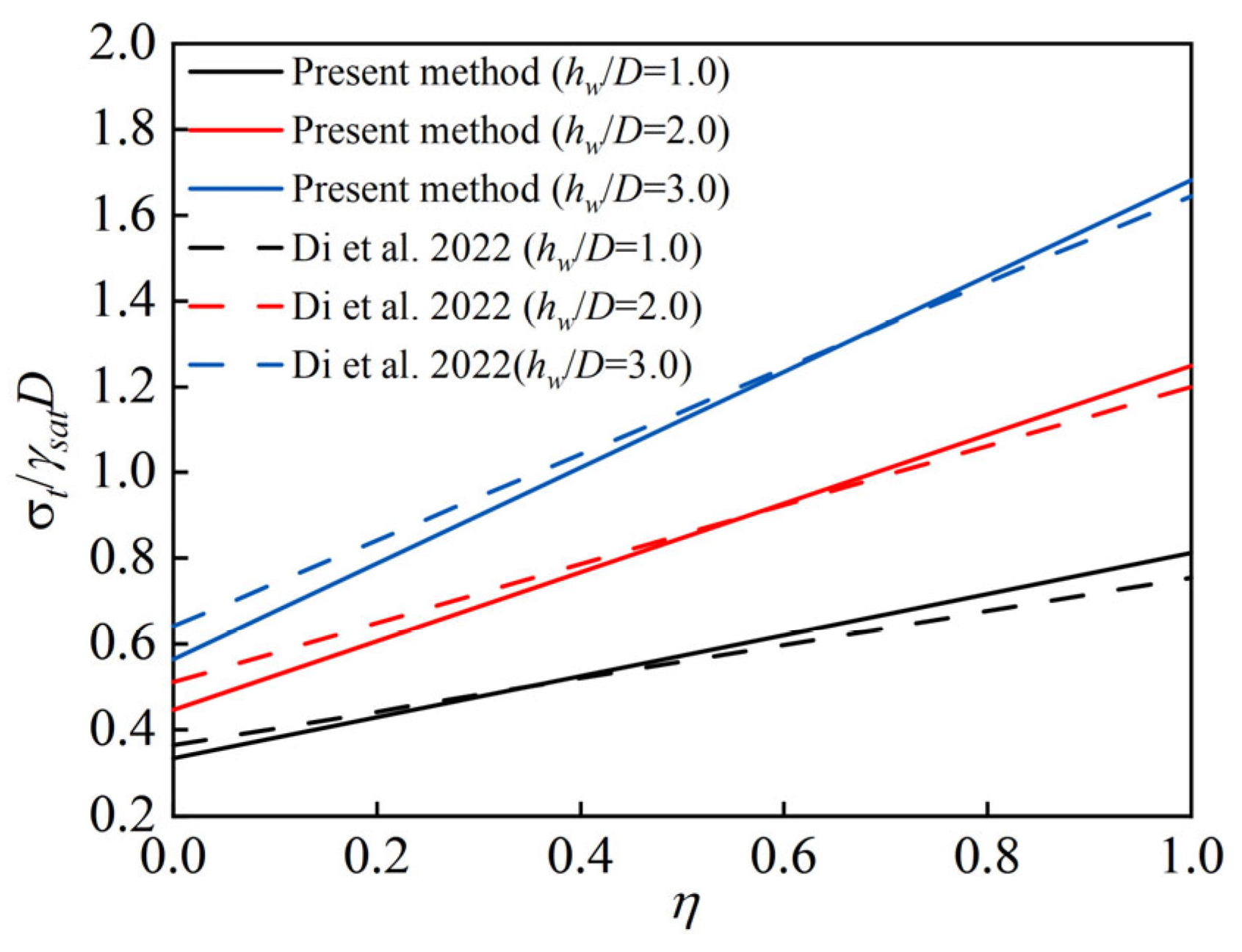
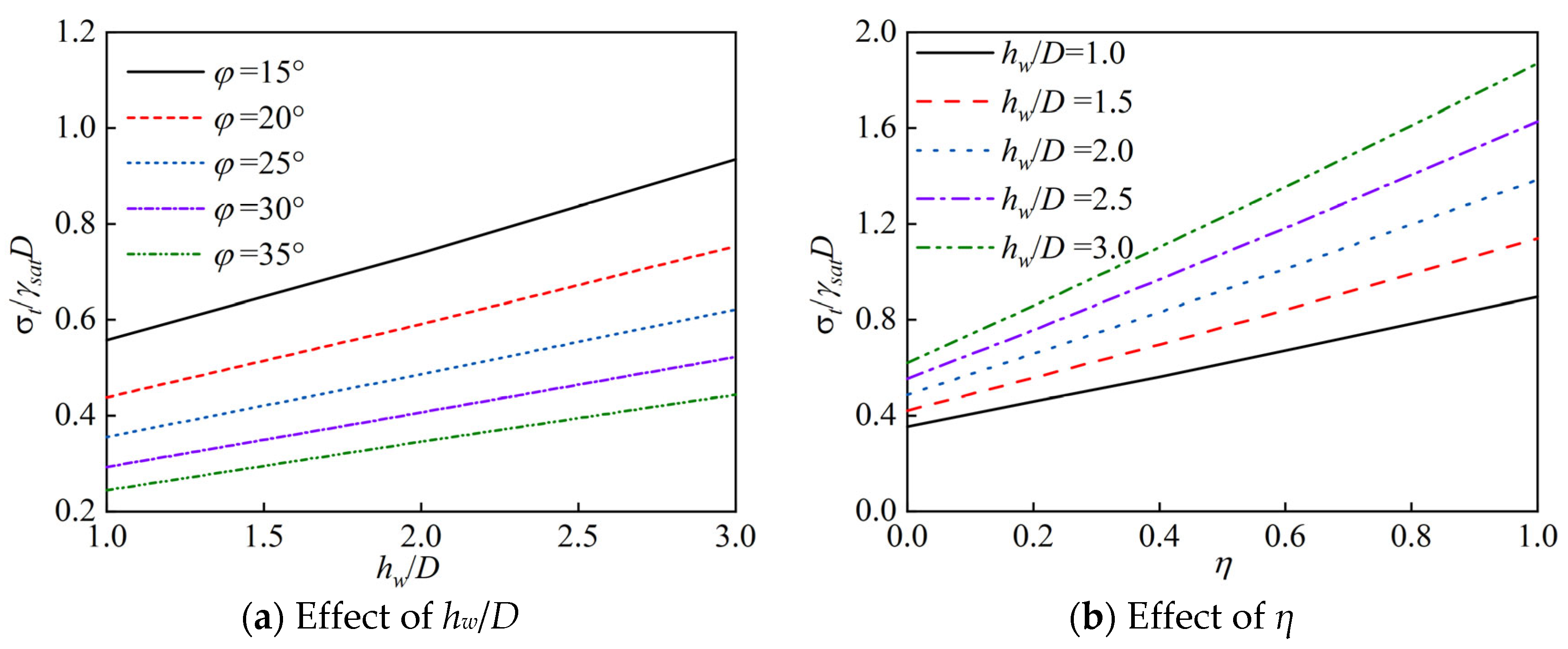
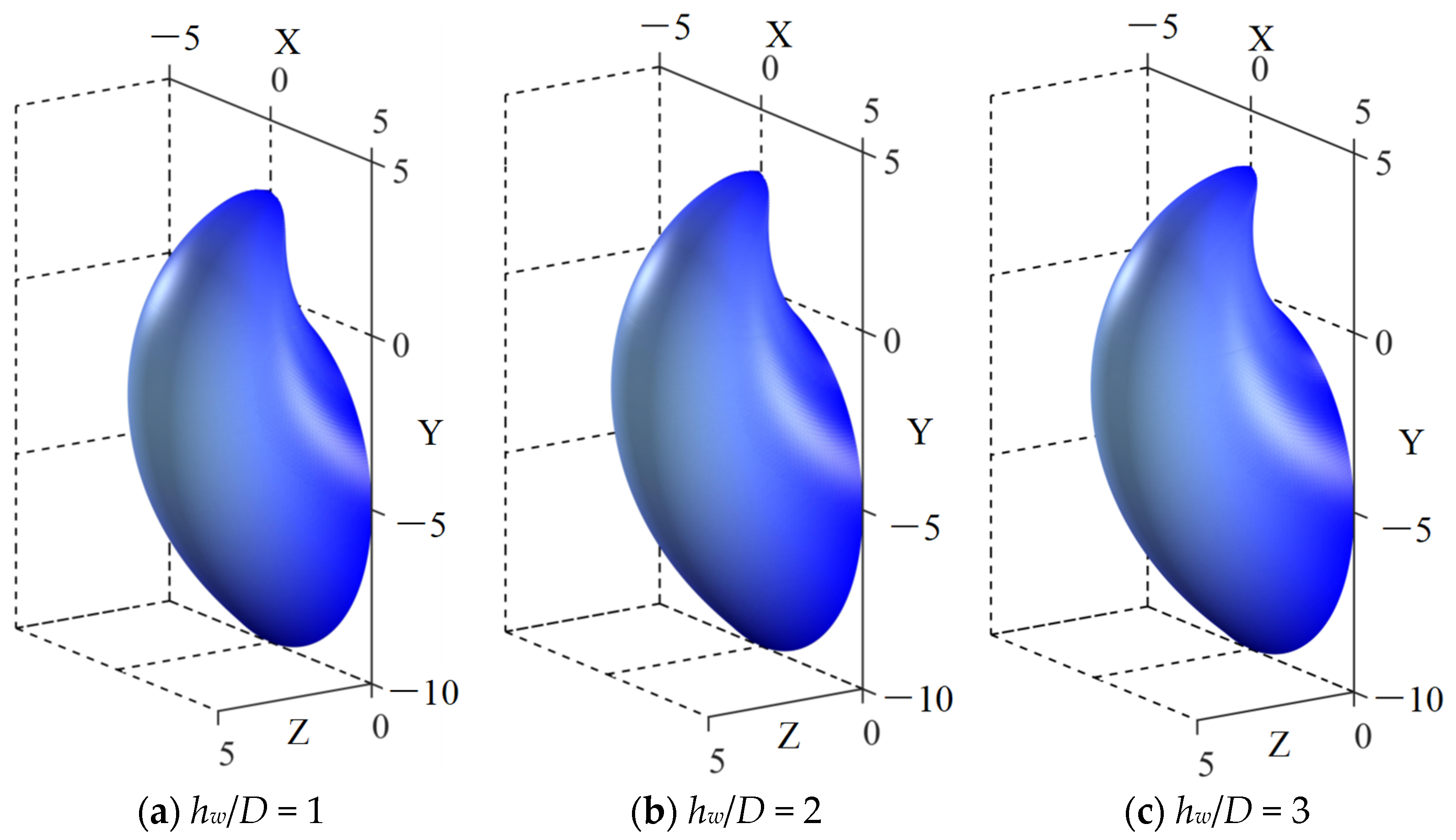
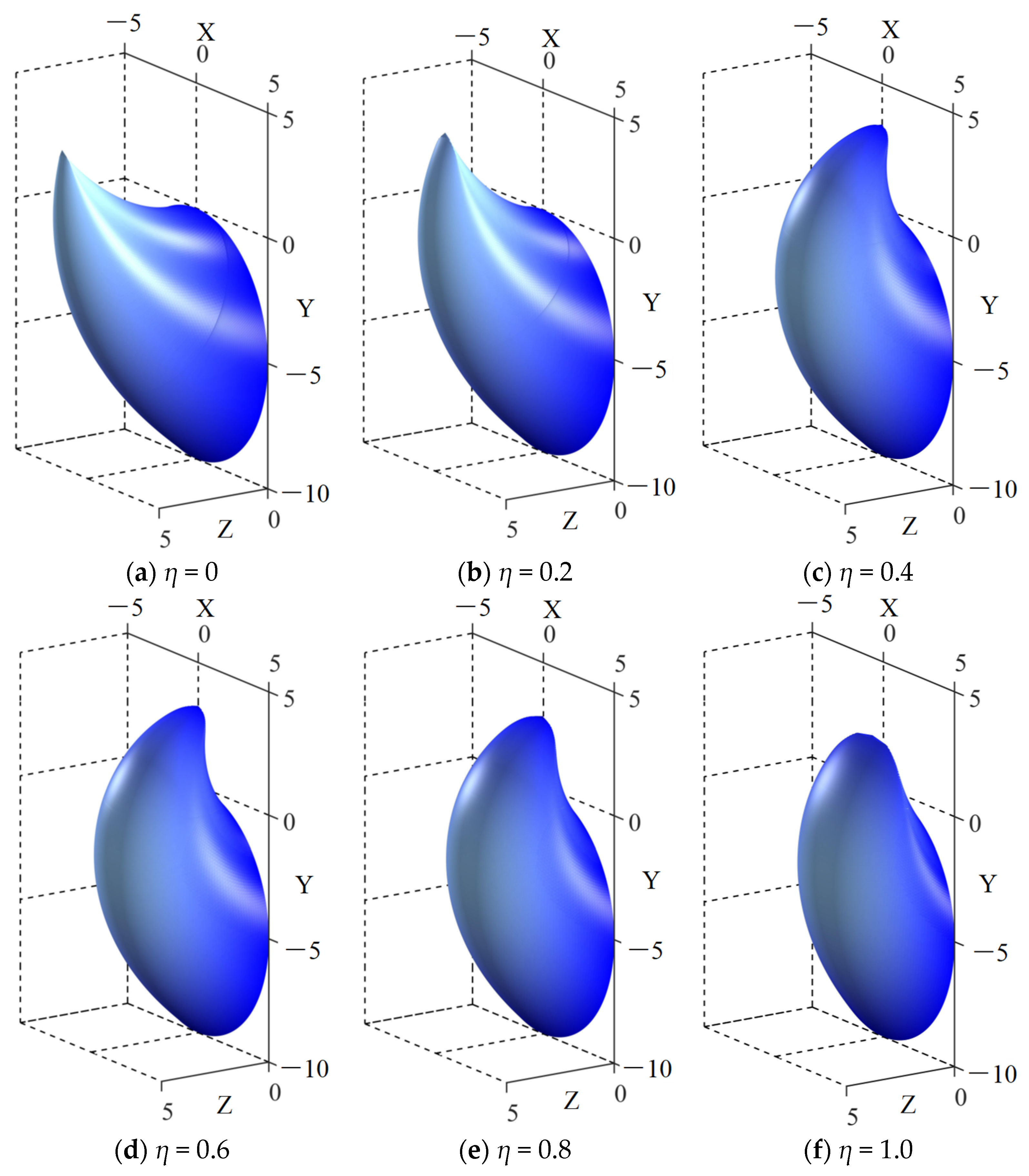


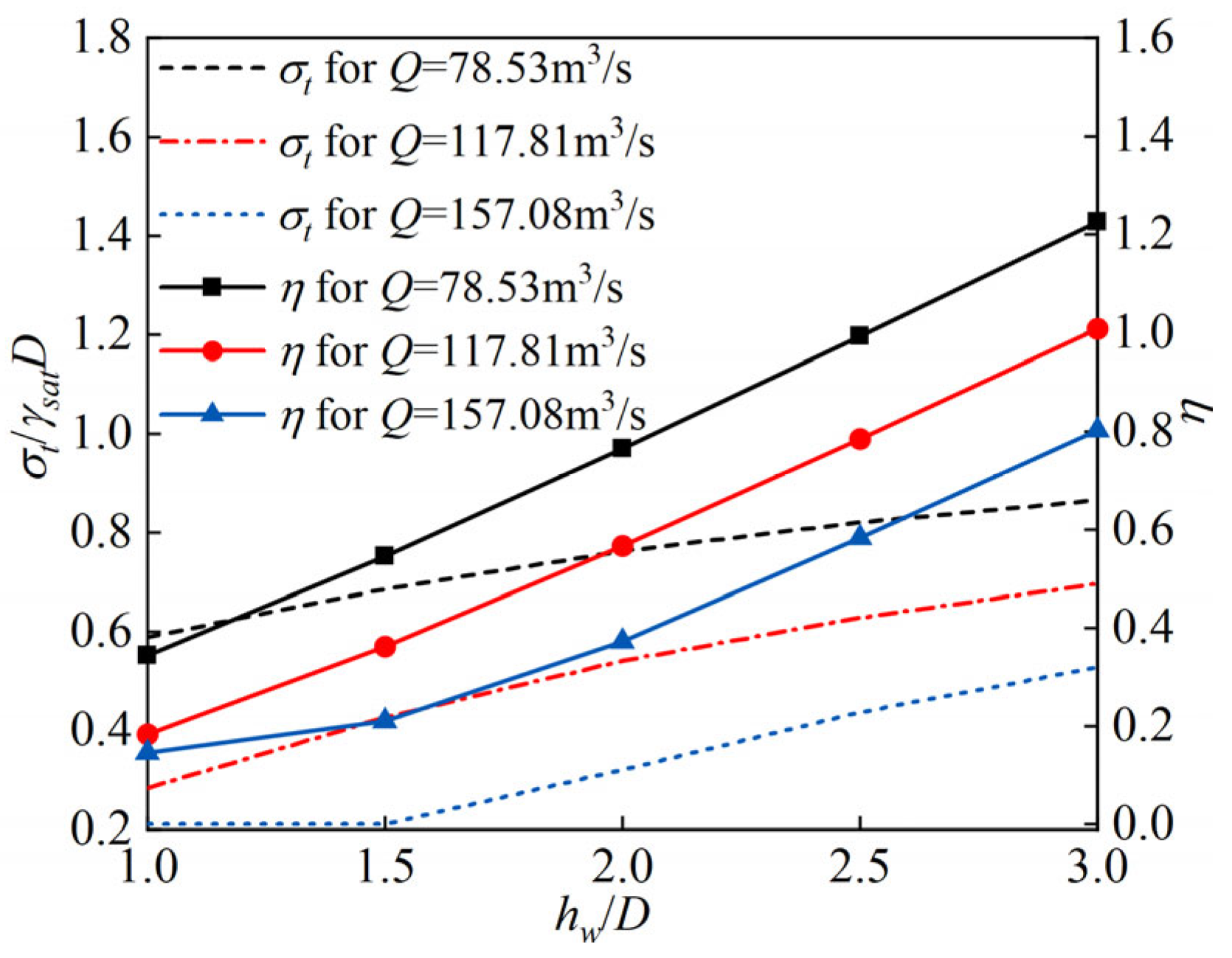
| hw/D | a | b | R2 (f2) | c | d | R2 (f4) |
|---|---|---|---|---|---|---|
| 1.0 | −0.0454 | 0.0315 | 0.982 | −0.1392 | 0.0793 | 0.983 |
| 1.5 | −0.0478 | 0.0350 | 0.981 | −0.0922 | 0.0440 | 0.985 |
| 2.0 | −0.0492 | 0.0318 | 0.980 | −0.0710 | 0.0317 | 0.987 |
| 2.5 | −0.0503 | 0.0325 | 0.979 | −0.0576 | 0.0343 | 0.987 |
| 3.0 | −0.0511 | 0.0330 | 0.979 | −0.0480 | 0.0376 | 0.988 |
| Support Pressure/kPa | Safety Factor | |
|---|---|---|
| The actual support pressure used | 209 | - |
| Considering seepage control | 149.8 (η = 0.96) | 1.4 |
| Not considering seepage control | 38.8 (η = 0) | 5.4 |
Disclaimer/Publisher’s Note: The statements, opinions and data contained in all publications are solely those of the individual author(s) and contributor(s) and not of MDPI and/or the editor(s). MDPI and/or the editor(s) disclaim responsibility for any injury to people or property resulting from any ideas, methods, instructions or products referred to in the content. |
© 2024 by the authors. Licensee MDPI, Basel, Switzerland. This article is an open access article distributed under the terms and conditions of the Creative Commons Attribution (CC BY) license (https://creativecommons.org/licenses/by/4.0/).
Share and Cite
Hu, Z.; Lei, M.; Zhang, H.; Jia, C.; Shi, C. Ultimate Support Pressure Determination for Shield Tunnel Faces in Saturated Strata Based on Seepage Flow Control. Appl. Sci. 2024, 14, 6781. https://doi.org/10.3390/app14156781
Hu Z, Lei M, Zhang H, Jia C, Shi C. Ultimate Support Pressure Determination for Shield Tunnel Faces in Saturated Strata Based on Seepage Flow Control. Applied Sciences. 2024; 14(15):6781. https://doi.org/10.3390/app14156781
Chicago/Turabian StyleHu, Ziwei, Mingfeng Lei, Hu Zhang, Chaojun Jia, and Chenghua Shi. 2024. "Ultimate Support Pressure Determination for Shield Tunnel Faces in Saturated Strata Based on Seepage Flow Control" Applied Sciences 14, no. 15: 6781. https://doi.org/10.3390/app14156781






